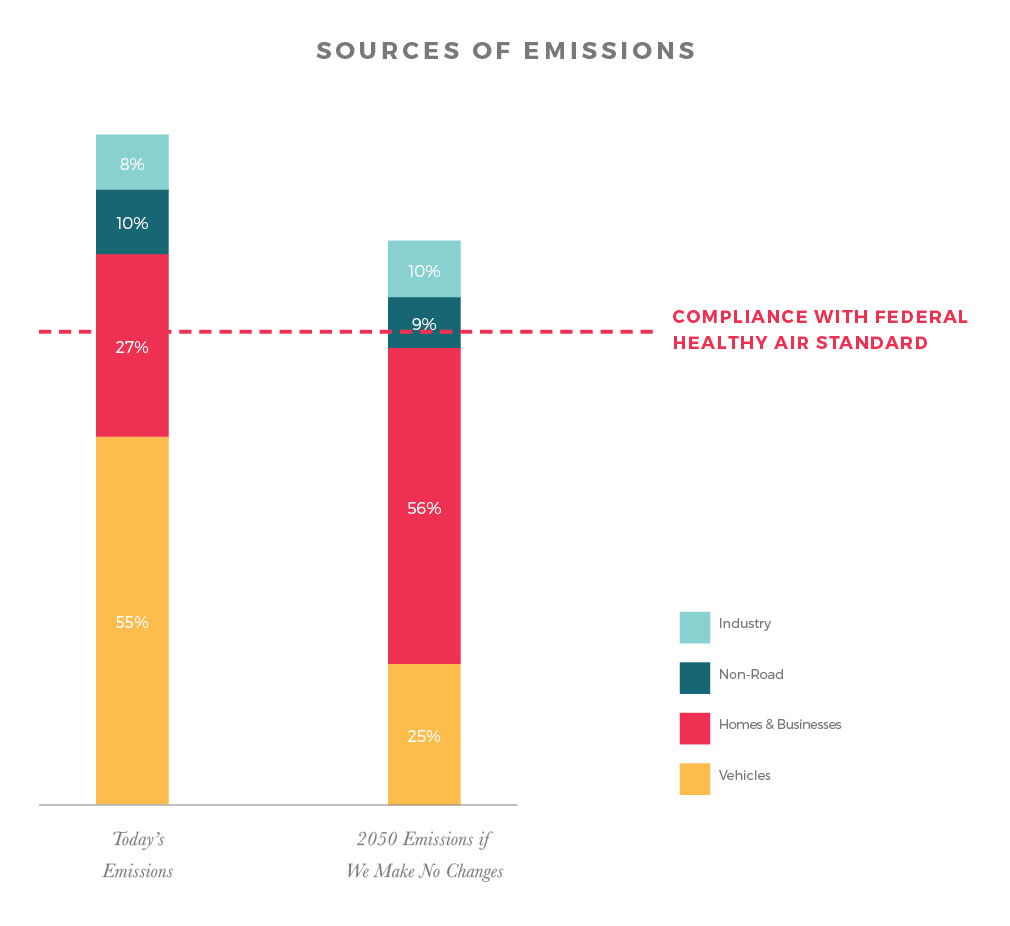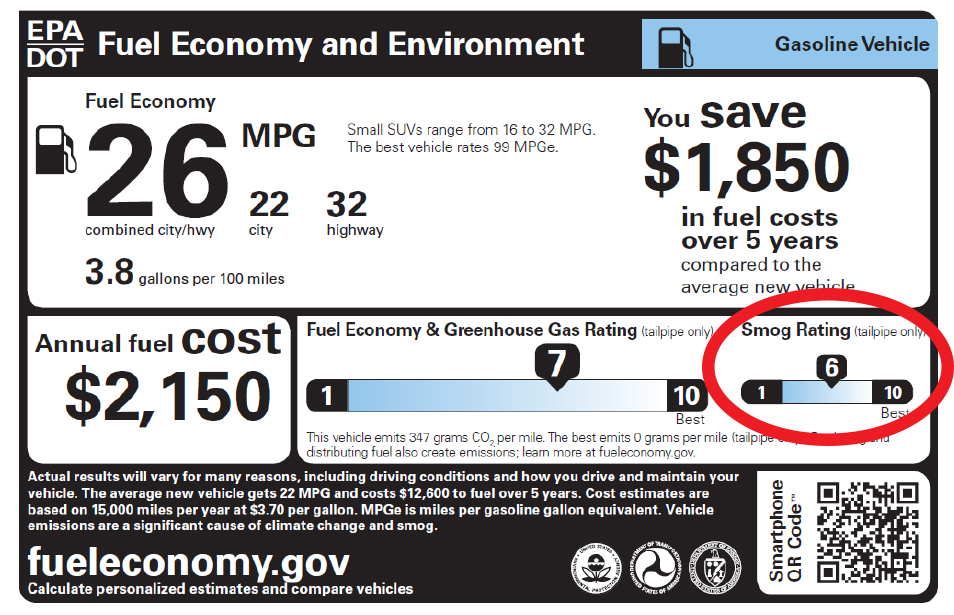Background:
Air Quality
in Utah
For Utahns, poor air quality is the greatest negative attribute of their quality of life and one of their strongest concerns. Utah’s air is clean much of the year, but in many parts of the state pollutants regularly exceed healthy air standards during winter months and also at times during the summer. Utahns view this air pollution as a threat to their health and their family’s health. They also find that poor air quality constrains their freedom to enjoy Utah’s beautiful outdoors and affects the state economy by discouraging businesses and employees from locating in Utah.
The sources of Utah’s air pollution are changing. Today, most emissions come from vehicle exhaust, but homes, commercial buildings, offices, and other structures will become the dominant sources of pollution by 2050. Utahns are willing to make significant changes to achieve cleaner air. Among other steps, Utahns are willing to buy and drive cleaner cars, switch to cleaner fuel, drive less, build significantly more energy-efficient homes and other buildings, and avoid wood burning during winter inversions.

Utahns care deeply about air quality. Over the past several years, they have rated it a top concern—it is the most cited negative attribute of life in Utah. Improving air quality is rising in priority because it impacts everything from individual health and well-being to the state’s overall economic growth.
For most of the year, Utah’s air is clean and meets federal health standards. But for some periods in the summer and particularly in the winter, regional weather patterns and topography, combined with emissions from various sources, cause poor air conditions along the Wasatch Front, in Cache Valley, and even in the Uintah Basin. The air has gotten significantly cleaner in the past 30+ years and will continue to improve in the near future as cars produce even fewer emissions. Unless Utahns make additional changes, however, population growth will prevent the state from meeting federal health standards in the decades to come.
Winter and summer air pollution is largely caused by the same emissions. Poor winter air quality is a result of tiny dust and soot particles known as particulate matter (PM2.5). These particles can become trapped in people’s lungs and cause or exacerbate negative health conditions. Roughly 25% of the PM2.5 that we see during winter inversions is directly emitted from a source (e.g., from burning wood), but the majority of the PM2.5 is created in the atmosphere through chemical reactions that require a combination of gases. These gases are emitted by a variety of sources, including vehicle exhaust, water heaters and furnaces, and industrial processes. Poor summer air quality is typically a result of ozone, an odorless, colorless gas that typically resides high in the atmosphere. When it exists in high concentrations closer to the ground, however, it can be detrimental to health. Summer ozone is not emitted directly into the atmosphere but instead forms through chemical reactions of many of the same pollutants that form PM2.5 in the winter.
Pollution-causing emissions come from four main sources: mobile sources, area sources, non-road mobile sources, and point sources. Mobile sources—cars and trucks—are the main source of air pollution today, causing 55% of winter emissions. Homes and businesses (more specifically, space heating, water heating, wood burning, etc.) are referred to as area sources and make up 27% of winter emissions. Included within area sources are also various household chemicals, aerosols, paints, emissions from food production and decaying plant/organic material, etc. Non-road mobile sources (engine-powered devices that operate off roadways, such as construction equipment, airplanes, boats, lawn mowers, snow blowers, etc.) cause 10% of winter emissions. Point sources are industry-related sources of pollution like power and industrial plants, and they make up 8% of winter emissions.
 Emissions from mobile sources will continue to decrease in the coming years. New federal regulations require the production of cleaner (lower-sulfur) fuels. Unfortunately, some Utah refineries could take advantage of exemptions to avoid producing the cleaner fuel. New regulations will also result in the gradual phase-in of cleaner cars. These cars, when combined with cleaner fuels, will reduce automobile emissions by 80%, which is enough to significantly decrease total Utah emissions, even with population growth. Utahns, however, do not have to wait for federal regulations to switch to cleaner cars. Vehicles with high smog ratings can already be purchased today. Smog ratings (a number on a one-through-ten scale) are given to all vehicles based on the amount of pollutants they emit from their tailpipes. Cleaner cars have smog ratings of eight or higher (you can find the smog rating on the window sticker of a new car or at fueleconomy.gov). The average car currently sold in Utah has a smog rating of six. A car with a smog rating of ten has no tailpipe emissions (e.g., an electric car).
Emissions from mobile sources will continue to decrease in the coming years. New federal regulations require the production of cleaner (lower-sulfur) fuels. Unfortunately, some Utah refineries could take advantage of exemptions to avoid producing the cleaner fuel. New regulations will also result in the gradual phase-in of cleaner cars. These cars, when combined with cleaner fuels, will reduce automobile emissions by 80%, which is enough to significantly decrease total Utah emissions, even with population growth. Utahns, however, do not have to wait for federal regulations to switch to cleaner cars. Vehicles with high smog ratings can already be purchased today. Smog ratings (a number on a one-through-ten scale) are given to all vehicles based on the amount of pollutants they emit from their tailpipes. Cleaner cars have smog ratings of eight or higher (you can find the smog rating on the window sticker of a new car or at fueleconomy.gov). The average car currently sold in Utah has a smog rating of six. A car with a smog rating of ten has no tailpipe emissions (e.g., an electric car).
Emissions from certain area and point sources will also decrease in the future. New state regulations (the State Implementation Plan, or SIP) require significantly reduced emissions from a variety of sources, including industry, household chemicals, paints, and other ambient area sources.
Homes and businesses, however, are not currently on the same trajectory as mobile and point sources. As the number of Utah homes and businesses nearly doubles by 2050, area sources (e.g., furnaces and water heaters) will become the dominant source of air pollutants. Improving energy efficiency and lowering the amount of pollutants emitted from both old and new buildings is crucial if Utah is to meet health standards over the long term.
Utah’s air has gotten cleaner and will continue to improve in the short term. But as the state continues to grow, even cleaner cars and the SIP will not be enough to keep the air clean over a long period of time.


